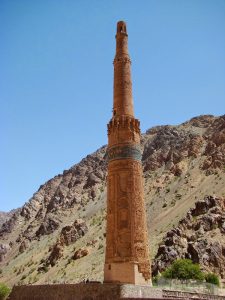The media portrayed it as harsh mountains harboring fighters, wastelands and a battlefield, but before the American invasion and before the Russian war and the communist experience of the country, Afghanistan was a completely different place.
In the 1960s, Afghanistan witnessed a modernization that reflected on the lives of its citizens. Both men and women went to universities, and the newly paved roads were crowded with cars.
The face you didn’t know about Afghanistan..
Historic monuments and monuments
Afghanistan is home to many beautiful historical archaeological sites, including:
Alexander Castle

Dating back to 330 BC in the heart of Herat Afghanistan, Alexander built the Herat Citadel when he arrived with his army in Afghanistan after the Battle of Gaugamela.
Various other empires used it as their headquarters for two millennia, during which it witnessed much destruction and subsequent rebuilding by the ruling dynasties.
In 1976, UNESCO excavated and restored the citadel, and in recent years several international organizations decided to completely rebuild it, to also include the National Museum in Herat.
Minaret (Mi’dhanah) of Jam

In the county is the Minaret of Jam, which has been designated a World Heritage Site by UNESCO.
The muezzin called for prayer from the top of this ancient tower, and the walls of the minaret were decorated with alternating bands of Kufic calligraphy, Naskh script, geometric patterns and verses from the Qur’an.
The circular minaret rests on an octagonal base, with two wooden balconies and a lamp, and is one of the famous tourist sites.
Despite the political struggles and the warring forces to impose their control in the heart of Asia, the beauty and rich heritage of Afghanistan is reflected in these historical monuments, which were created after rulers in the past decided to turn them into their home.
Home to great scholars
The country of Khorasan was home to the graduation of great figures of Islamic clerics, among whom we mention:
Imam Ibn Hibban
Ibn Hibban al-Busti (270 AH – 354 AH = 884 AD – 965 AD) is the imam, the scholar, the hafiz, the hadith, the historian, the judge, the Sheikh of Khorasan, one of the leading imams of hadith, al-jarh and modification.
Mullah Ali Al Qari
He is Nur al-Din Abu al-Hasan Ali bin Sultan Muhammad al-Qari, al-Harawi al-Makki, better known as Mullah Ali al-Qari, his father’s name: Sultan. He was born in Herat, and he is one of the most prominent Sufi sheikhs, and he learned from the prominent people of the Sunnah and the Jama’ah from the Maturidi.
Abu Dawood
Abu Dawud Suleiman bin Al-Ash’ath bin Ishaq bin Bashir Al-Azdi Al-Sijistani, known as Abu Dawood (202-275 AH) was the imam of the people of hadith in his time, the modernizer of Basra, and he is the author of his famous book Sunan Abi Dawood. Makran, the land of Baloch, the Azd is called Sajistan, and he was one of the students of Imam Ahmad bin Hanbal, may God be pleased with him
We list below the most important scholars:
- Abu Ishaq Al-Isfaraini
- Abu Al-Hussein Al-Naysaburi
- Abu Sheikh Al-Asbahani
- Abu al-Faraj al-Isfahani
- Abu al-Qasim al-Rafi’i al-Qazwini
- Ibn Fourak
- Ibn Majah
- Abu Awana Al-Isfaraini
- Abu Issa Muhammad al-Tirmidhi
- Abu Naim Al-Asbahani
- Ahmed bin Shuaib women
- Ibn Al-Jazari
- Imam Tabarani
Sunna Files Free Newsletter - اشترك في جريدتنا المجانية
Stay updated with our latest reports, news, designs, and more by subscribing to our newsletter! Delivered straight to your inbox twice a month, our newsletter keeps you in the loop with the most important updates from our website











